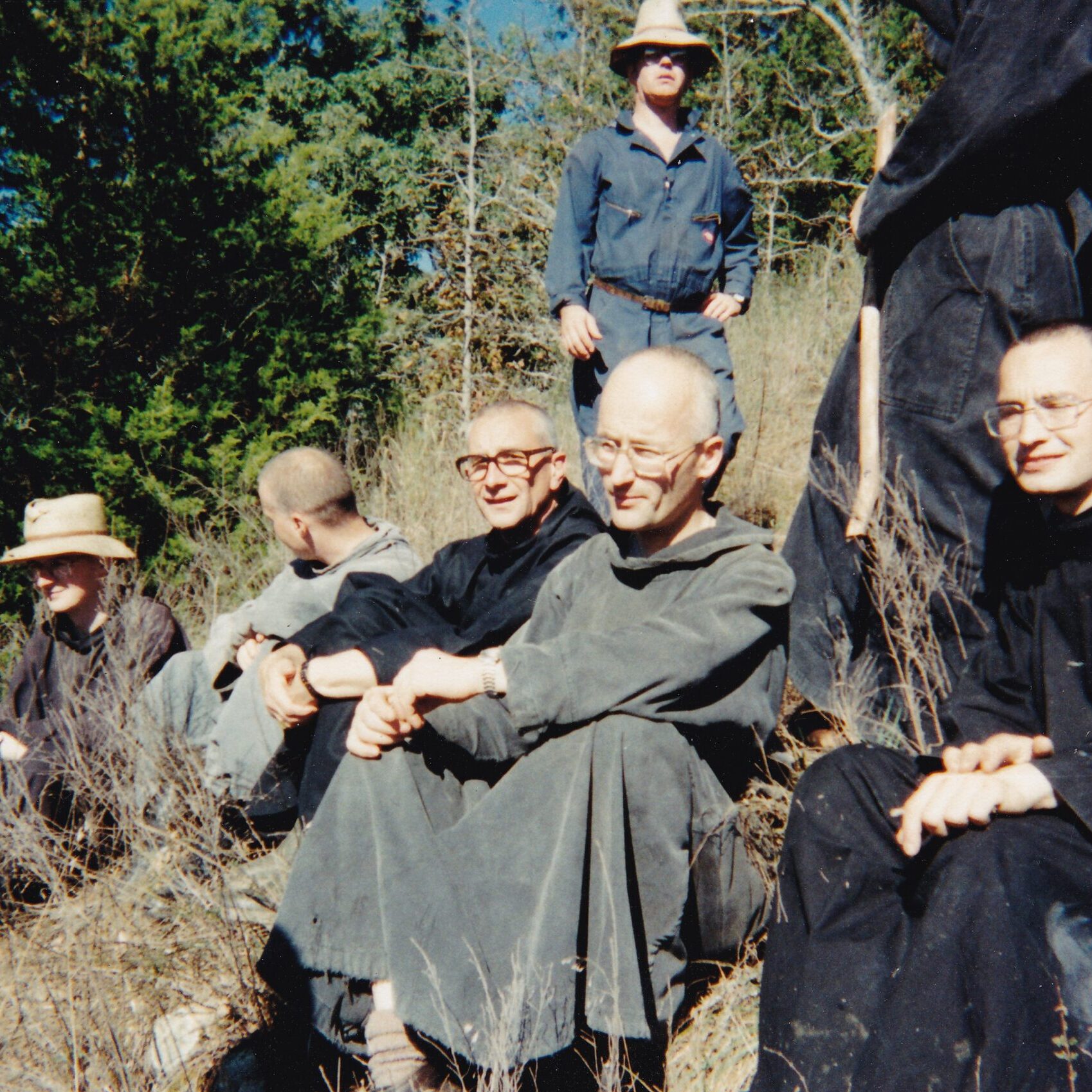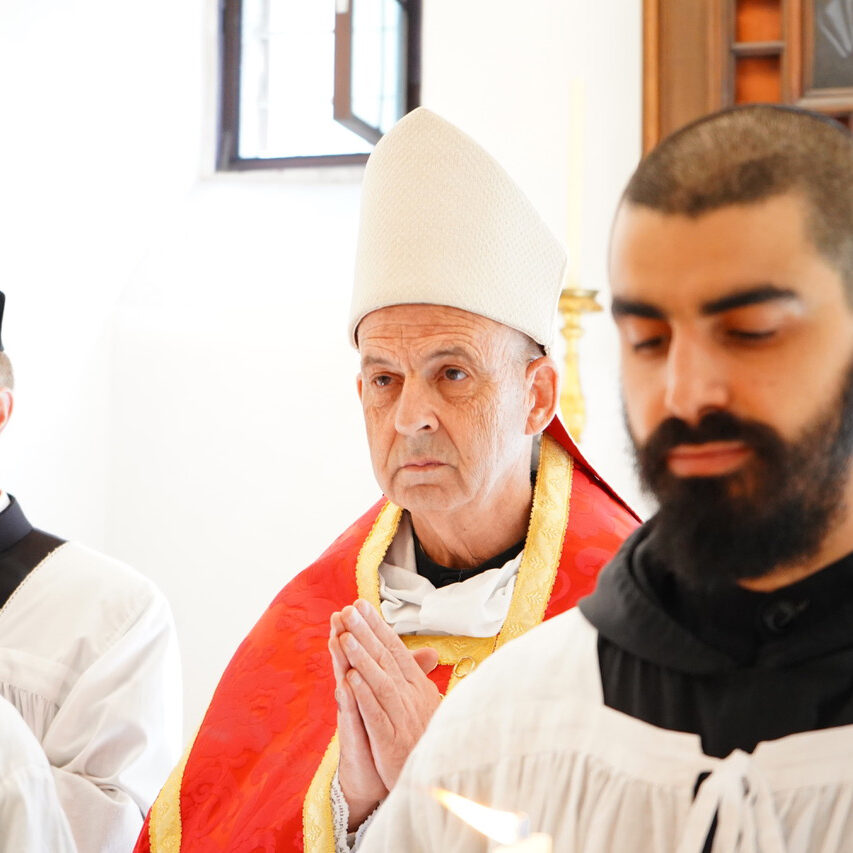Tower of David, pray for us
Tower of ivory, pray for us
House of gold, pray for us
Ark of the covenant, pray for us
Gate of Heaven, pray for us
Morning Star, pray for us …
Dear Friend of Clear Creek,
It is pure joy to speak about the Blessed Virgin Mary, especially during the month of May, even as our poor words seek in vain to say what cannot be expressed in human language. The prince of Christian poets, Dante, in his vision of Heaven, described her as a “beauty that was gladness in the eyes of all the other saints” (Paradiso, XXXI, 138).
Some have voiced the opinion that in the past the Church has exalted Our Lady in a somewhat misguided way — “heaping up,” as it were, “her privileges and exemptions.” While in our own time, so the argument goes, the faithful have learned to see Mary in a truer light, as being closer to our own earthly, day-to-day existence. But must we really stop exalting Mary, so as to discover her in a more down-to-earth way?
First of all, we should point out that the impressive list of Our Lady’s privileges, as defined by the Magisterium of the Church — privileges such as her quality as Mother of God, her Immaculate Conception and her Assumption into Heaven — can scarcely be likened to a “heap,” unless you are thinking of a heap of gold or of precious stones. After all, who is at fault, if God has thus decreed to bestow upon His mother such treasures of grace? Did not Mary herself predict this accumulation, when she sang her canticle of praise, her Magnificat? “Behold from henceforth all generations shall call me blessed. Because he that is mighty hath done great things for me…” (Lk. 1:48-49) Rather than a “heap” of privileges we would do better to see in the Blessed Virgin a spiritual architecture of incomparable harmony and proportion. No wonder the Litany of Loretto refers to Mary as House of Gold.
In truth this woman — whose unique vocation was to be the new Eve who restores what the first Eve destroyed — is the one whose existence is constantly being lifted up by God. In her very conception, by virtue of the inexorable law of original sin, she should have become a child like any other, wounded and soiled by the fault of the beginnings. Instead she is raised to a condition of exemption from even the slightest shadow of sin. “I am the Immaculate Conception” she declared to little Bernadette Soubirous, at Lourdes a little over 150 years ago.
At the other end of Mary’s life, by another privilege that surpasses our capacity to comprehend, the Virgin of Nazareth was quite literally lifted up, body and soul, into the glory of Heaven, without having known the corruption of the tomb. It is little wonder that the Church sees in the mysterious “woman clothed with the sun” (as described in the Book of Revelation) a figure of the Assumpta.
None of these exaltations, however, can compare with Our Lady’s promotion to the dignity of her Divine Motherhood. All that she received before was in view of this central fact; all that follows in her life is but its consequence, including her Assumption into Heaven. In becoming the Mother of Christ and therefore the Mother of God, Mary enters into the very order of the hypostatic union. The Holy Angels themselves adore in silence and in wonder this design of Divine Providence, this uplifting of a human creature to such an exalted purpose. “Quae est ista… Who is she that goeth up by the desert, as a pillar of smoke of aromatical spices … that cometh forth as the morning rising, fair as the moon, bright as the sun, terrible as an army set in battle-array?” (Cant. 3:6; 6:9) Truly, Mary is a Lady divinely uplifted.
It is true that we should not see in Mary a goddess, a being so exalted as no longer to be counted as our own sister in humanity. The privileges from which she benefits can only make her closer to us. It must be admitted that, in certain times and places, Christians have fallen into exaggerated forms of Marian devotion. However, to view this question of a clear-sighted Marian devotion in terms of “before Vatican II” and “after Vatican II” runs the risk of joining that false interpretation of history that the Holy Father, Pope Benedict XVI, has so astutely referred to as the “hermeneutics (interpretation) of rupture.” This type of interpretation, constantly contrasting the old way and the new way, fails to see that Christian Dogma and doctrine develop in continuity, like a living thing, rather than by revolution. Our understanding of the mystery of Mary continues to develop, bringing new insights, but along the very same lines set down from the beginning.
We certainly need to feel that Our Lady is close to us, but if ever there was a time in which human beings needed to be reminded of exalted and heavenly things — of purity and light not of this world — it is surely ours. While politicians and the shapers of popular culture lead us bravely downward, along the slippery slope into a moral quagmire never dreamed of by those prophets of doom who wrote of 1984 and a Brave New World, we stand in need of a heavenly reference point, of a guiding star. As we watch the Gospel of Life being trampled under foot in ever newer ways, we have to remember to look up to the stars. Gate of Heaven, Morning Star, pray for us. Lady, uplift us!
br. Philip Anderson, Prior
Tower of David, pray for us
Tower of ivory, pray for us
House of gold, pray for us
Ark of the covenant, pray for us
Gate of Heaven, pray for us
Morning Star, pray for us …
Dear Friend of Clear Creek,
It is pure joy to speak about the Blessed Virgin Mary, especially during the month of May, even as our poor words seek in vain to say what cannot be expressed in human language. The prince of Christian poets, Dante, in his vision of Heaven, described her as a “beauty that was gladness in the eyes of all the other saints” (Paradiso, XXXI, 138).
Some have voiced the opinion that in the past the Church has exalted Our Lady in a somewhat misguided way — “heaping up,” as it were, “her privileges and exemptions.” While in our own time, so the argument goes, the faithful have learned to see Mary in a truer light, as being closer to our own earthly, day-to-day existence. But must we really stop exalting Mary, so as to discover her in a more down-to-earth way?
First of all, we should point out that the impressive list of Our Lady’s privileges, as defined by the Magisterium of the Church — privileges such as her quality as Mother of God, her Immaculate Conception and her Assumption into Heaven — can scarcely be likened to a “heap,” unless you are thinking of a heap of gold or of precious stones. After all, who is at fault, if God has thus decreed to bestow upon His mother such treasures of grace? Did not Mary herself predict this accumulation, when she sang her canticle of praise, her Magnificat? “Behold from henceforth all generations shall call me blessed. Because he that is mighty hath done great things for me…” (Lk. 1:48-49) Rather than a “heap” of privileges we would do better to see in the Blessed Virgin a spiritual architecture of incomparable harmony and proportion. No wonder the Litany of Loretto refers to Mary as House of Gold.
In truth this woman — whose unique vocation was to be the new Eve who restores what the first Eve destroyed — is the one whose existence is constantly being lifted up by God. In her very conception, by virtue of the inexorable law of original sin, she should have become a child like any other, wounded and soiled by the fault of the beginnings. Instead she is raised to a condition of exemption from even the slightest shadow of sin. “I am the Immaculate Conception” she declared to little Bernadette Soubirous, at Lourdes a little over 150 years ago.
At the other end of Mary’s life, by another privilege that surpasses our capacity to comprehend, the Virgin of Nazareth was quite literally lifted up, body and soul, into the glory of Heaven, without having known the corruption of the tomb. It is little wonder that the Church sees in the mysterious “woman clothed with the sun” (as described in the Book of Revelation) a figure of the Assumpta.
None of these exaltations, however, can compare with Our Lady’s promotion to the dignity of her Divine Motherhood. All that she received before was in view of this central fact; all that follows in her life is but its consequence, including her Assumption into Heaven. In becoming the Mother of Christ and therefore the Mother of God, Mary enters into the very order of the hypostatic union. The Holy Angels themselves adore in silence and in wonder this design of Divine Providence, this uplifting of a human creature to such an exalted purpose. “Quae est ista… Who is she that goeth up by the desert, as a pillar of smoke of aromatical spices … that cometh forth as the morning rising, fair as the moon, bright as the sun, terrible as an army set in battle-array?” (Cant. 3:6; 6:9) Truly, Mary is a Lady divinely uplifted.
It is true that we should not see in Mary a goddess, a being so exalted as no longer to be counted as our own sister in humanity. The privileges from which she benefits can only make her closer to us. It must be admitted that, in certain times and places, Christians have fallen into exaggerated forms of Marian devotion. However, to view this question of a clear-sighted Marian devotion in terms of “before Vatican II” and “after Vatican II” runs the risk of joining that false interpretation of history that the Holy Father, Pope Benedict XVI, has so astutely referred to as the “hermeneutics (interpretation) of rupture.” This type of interpretation, constantly contrasting the old way and the new way, fails to see that Christian Dogma and doctrine develop in continuity, like a living thing, rather than by revolution. Our understanding of the mystery of Mary continues to develop, bringing new insights, but along the very same lines set down from the beginning.
We certainly need to feel that Our Lady is close to us, but if ever there was a time in which human beings needed to be reminded of exalted and heavenly things — of purity and light not of this world — it is surely ours. While politicians and the shapers of popular culture lead us bravely downward, along the slippery slope into a moral quagmire never dreamed of by those prophets of doom who wrote of 1984 and a Brave New World, we stand in need of a heavenly reference point, of a guiding star. As we watch the Gospel of Life being trampled under foot in ever newer ways, we have to remember to look up to the stars. Gate of Heaven, Morning Star, pray for us. Lady, uplift us!
br. Philip Anderson, Prior






